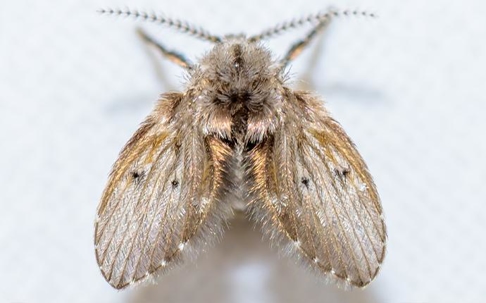Where Do Drain Flies Come From?
Drain flies are small and lay even smaller eggs. They grow in any standing water source with a build-up of organic matter. Due to their appearance, some people confuse the adults for moths or baby house flies.
Locations where drain flies lay eggs include:
- Sewage areas
- Drains
- Refrigerator drain pans
- Toilet bowls that aren’t often used
- Poorly maintained gutters or drainage systems
Drain flies are also known as sewer flies. The adults find these locations suitable because the larvae that emerge from their eggs will feed on microbes in standing water. Eggs take under two days to hatch, and the larvae develop over the course of eight to 24 days. Following a quick 30-hour pupal stage, adults live for two weeks.
Why Is It So Hard To Get Rid Of Drain Flies?
It won’t take long to see these little flies everywhere in your house if they’ve found what they’re looking for. Even if you manage to kill all the adult drain flies, it seems like they just reappear within a few days. The secret to their endured presence is the larval stage. Each adult female can leave 30 to 100 eggs. That means each little fly you see could have set up a new generation waiting to pester you two to three weeks later.
Attacking just the swarm of flies won’t get rid of the problem. The larvae growing in drains, sewage areas, and other standing water sources will prove a redundant infestation if not treated. And since the younger life cycles are nearly microscopic, knowing where these larvae are developing isn’t easy. It can be anywhere in the house with the slightest pool of water, under floorboards, or behind walls.
Five Tips To Deter Drain Flies
If you want to keep these pests from getting out of hand, you can be more aware of how to prevent larvae from developing. Some helpful tips to deter or get rid of drain flies are:
- Treat drains with bleach and boiling water.
- Fix leaky pipes, gutters, and drainage systems.
- Dry up all sources of standing water.
- Clear out clutter in the yard so water doesn’t build up.
- Refresh and refill any necessary water sources like pet bowls.
The main thing to remember is the larvae take one to three weeks to mature. This gives you plenty of time to oust them. Remove and dry up any standing water, deprive the adults of locations to leave their eggs, and kill existing larvae. The adults can be a bother, too, but if you don’t treat the locations for potential new generations, you’ll end up with an incessant problem.
How To Get Rid Of Drain Flies In Kittitas County For Good
Even with the most diligent deterrent strategies, tiny drain flies are capable of infesting properties. They can find water sources you might not have considered and some that you might not even know existed. If a drain fly population is out of control, you may need professional assistance.
At Prosite, we have a proven track record with servicing Kittitas County. We approach our pest control methods with the latest technology, skillful precision, and analytical tactics. Contact us if you are under attack from any infestation.

